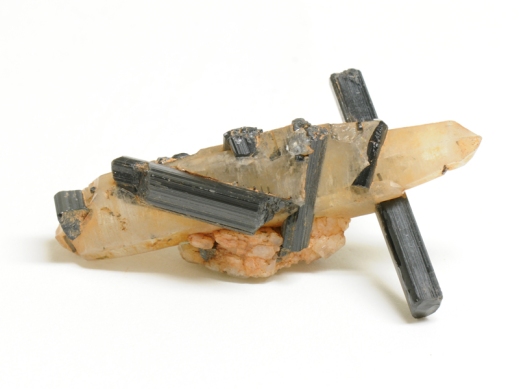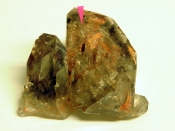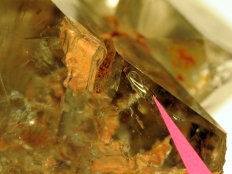Location, Location, Location!

McKissick Museum’s mineral collection originates from all around the world. Nearly every continent is represented – save for Antarctica. Some of these locations produce fantastic specimens, or are type localities (the location where a mineral was first discovered), while other locations are no longer open for collection.
As you might expect, our mineral collection contains specimens from many southeastern localities. North Carolina, for example, produces enhydro quartz, an uncommon habit in which quartz crystals formed with tiny pockets of gas or liquid in them. This quartz crystal is from Iredell County, North Carolina. The pink arrow is pointing to two movable air bubbles in the same pocket, which is how we know that there is water in the crystal. It’s pretty amazing to think that water from millions of years ago can be preserved in a crystal!
Minas Gerais, a state in Brazil, is another site that produces interesting specimens. Some of its mines date back to the late 1600’s, when Portuguese explorers discovered gold there. Mining played an important part in Minas Gerais’s history, and the name itself roughly translates to “general mines.” Gold was the primary goal, but other minerals found in Minas Gerais were also valuable. McKissick has two gemstone-quality crystals on display from this locality, with twenty-six more specimens in the collection. The images above, represent a small sample of McKissick’s Minas Gerais specimens.
Another famous mineral collecting locality is Tsumeb, Namibia. Like Minas Gerais, the area was established by a colonial power as a means to extract the wealth of the land. In this case, it was Germany who first profited from the incredible variety and quality of Tsumeb’s minerals. Tsumeb is known for containing superior specimens of dioptase, azurite, and malachite. The unique combination of metals and other elements that form the basis for minerals also means that there are at least twenty mineral specimens found only in Tsumeb. McKissick’s specimens from this location do Tsumeb’s reputation justice.
Brian Dolphin and Allison Baker McKissick Museum The Institute of Museum and Library Services is the primary source of federal support for the nation’s 123,000 libraries and 17,500 museums. The Institute’s mission is to create strong libraries and museums that connect people to information and ideas.




